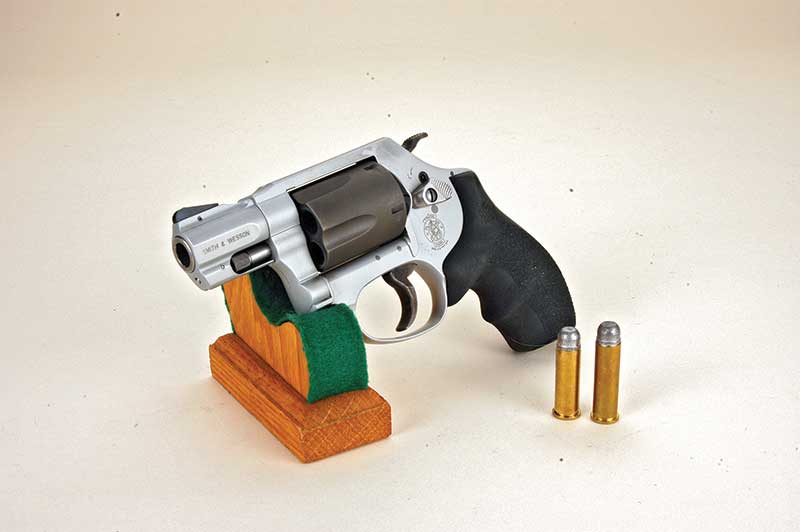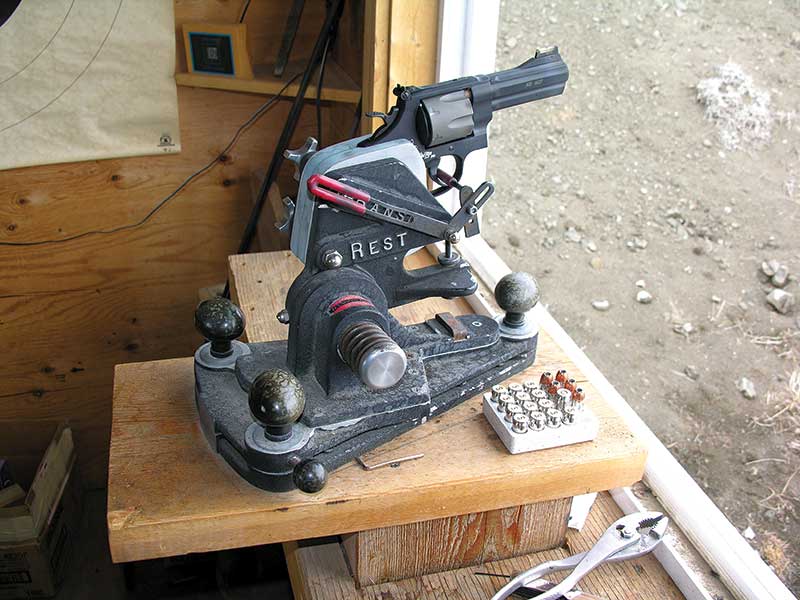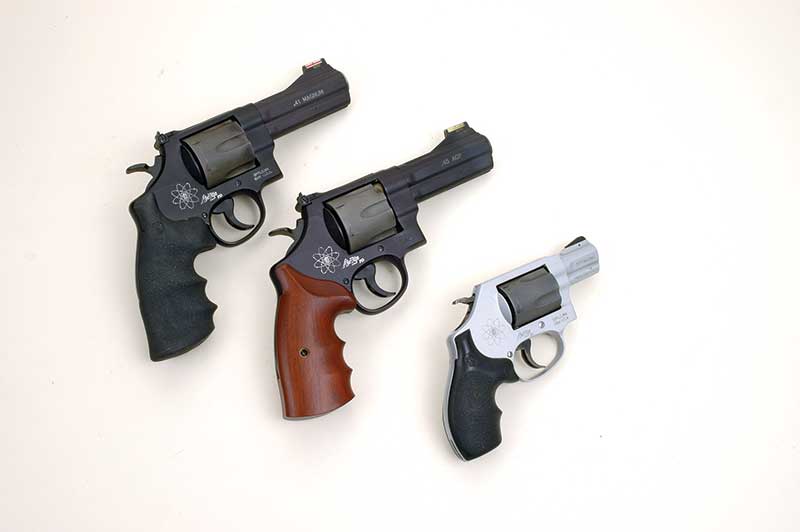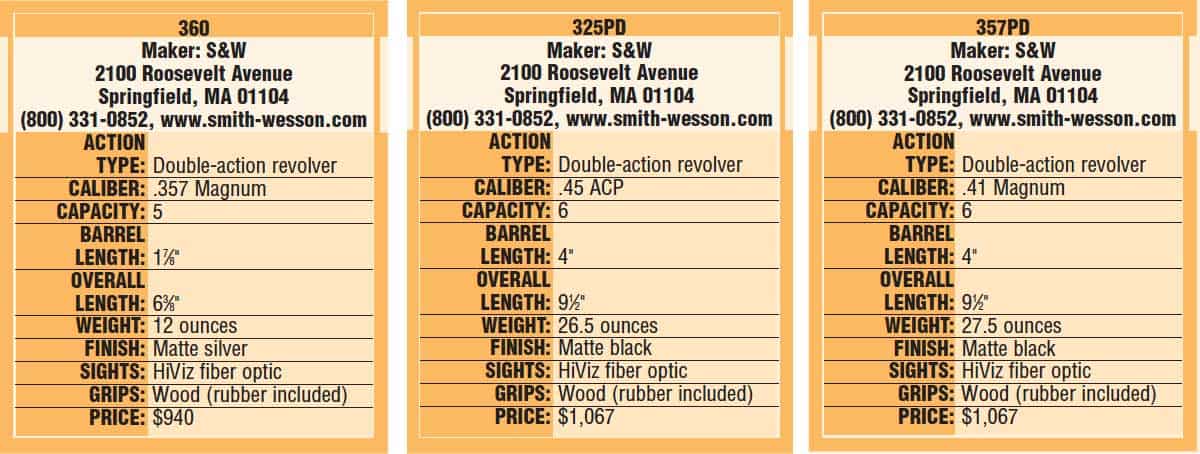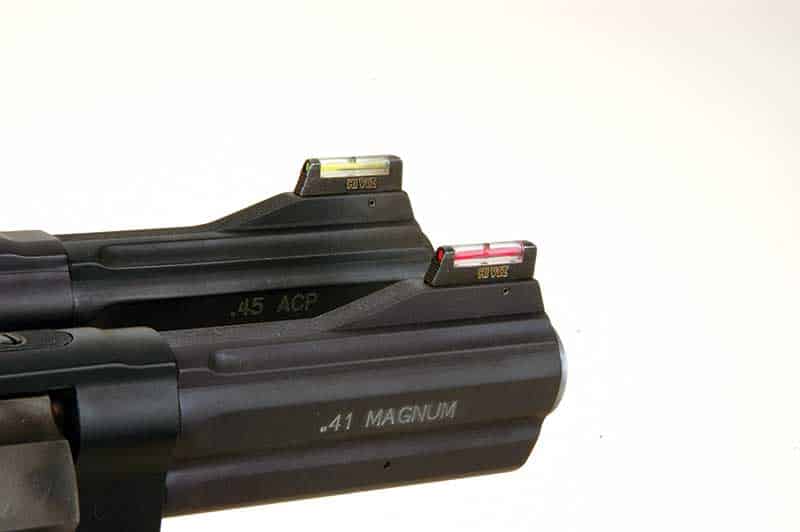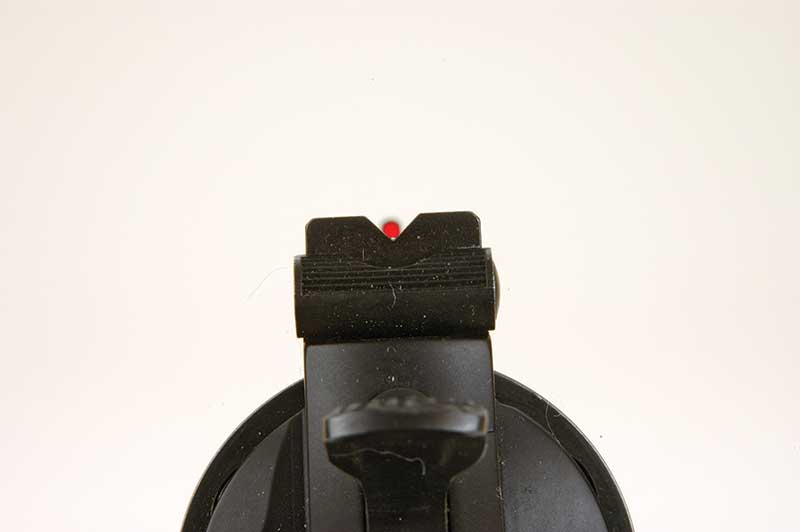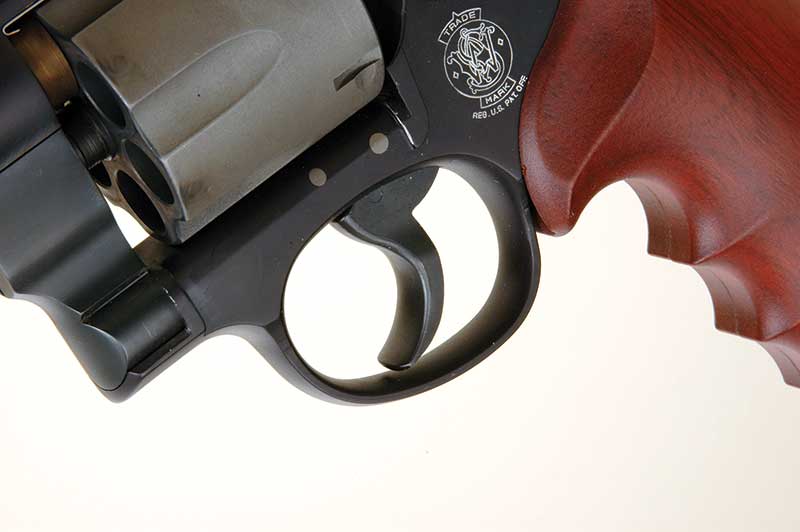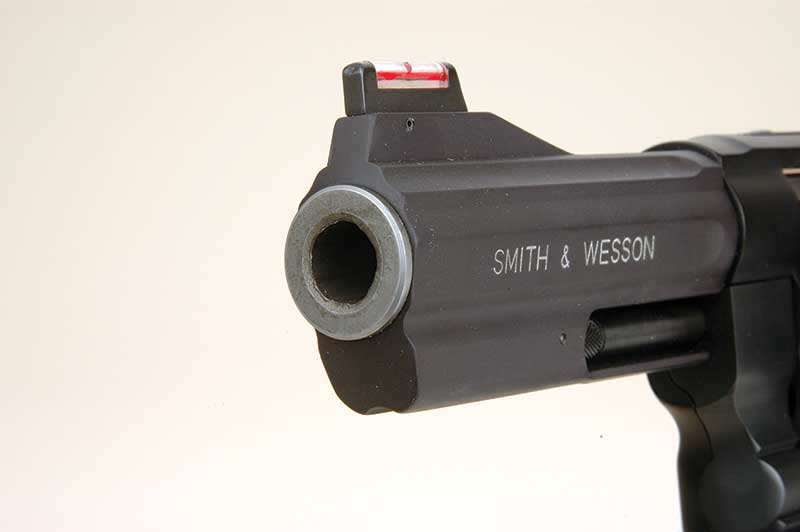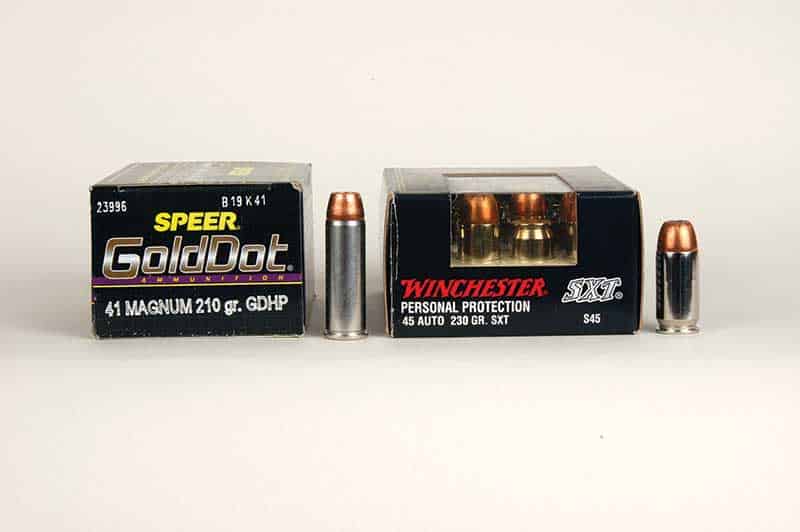Light As Feathers
S&W’s AirLites are tough as nails, too.
It is quite embarrassing for a gunwriter who has made most of a career out of covering antique, obsolete, classic and historical firearms to admit an infatuation with a brand new genre of guns. But I am. Many times in the past I’ve bragged there is nothing of new manufacture I’m about to spend my own money on except replicas and reproductions of fine old 19th century firearms. I’ve even said, “My guns are going to be made of wood and steel. There’s no room in my gun vault for synthetics.”
Now I must eat my own words because I’m going to buy at least one of the three brand new revolvers Smith & Wesson has sent me to try. Furthermore, my wife and I have been fighting over who gets it, so it’s likely we’ll end up with another. These are Smith & Wesson’s AirLite revolvers combining frames of Scandium alloy, cylinders of titanium alloy and barrels of stainless steel. Revolvers have been around for nigh on 200 years. What’s so captivating about these? They are light — light as feathers — at least compared to traditional steel revolvers. The little J-frames are a nominal 12 ounces. Even the big N-frames in .41 or .44 Magnum weight 27.5 ounces or less.
Right now I can hear the naysayers, “Why those things will tear your hand off! Recoil will be terrible! A .41 or .44 Magnum weighing less than two pounds? Shooting it would be torture!” Yeah, buddy, all that stuff is right. Smith & Wesson’s new breed of AirLite revolvers are no picnic with full-bore loads. Hells bells, they’re not even fun shooting Special-type loads in place of Magnums.
They’re Not Meant To Be
These AirLite handguns are for packing, for carrying on the body for long periods of time without being a terrible burden. For those of who have never packed a revolver for hours at a time, let me clue you in. They get tire-some real fast. Autoloaders like the Model 1911 are easier, if for no other reason than they are flat. Put an aluminum-framed one in an inside the pants holster, bind it to your side with a belt and it’s not too bad. Conversely, the revolver’s cylinder bulge makes them look like a rattlesnake just swallowed a gopher. Make them large-frame steel ones and then put it on your belt and take off for the hills afoot or on horseback for a 10- or 12-hour day. You’ll experience true relief in camp when you shed that handgun.
Back in the 1970s and 1980s I often did so with my long-owned Smith & Wesson Model 29 .44 Magnum when riding and camping in the grizzly bear habitat bordering the north boundary of Yellowstone National Park. I can honestly say I grew to hate wearing a handgun and I have the utmost respect and even sympathy for cops who tote an equipment belt around day in and day out.
Thoughtful, Careful Planning
I discovered Smith & Wesson’s line of AirLite revolvers kind of by accident. Here’s how it went. Back in the spring of 2006 I was on a varmint hunt with Clint Smith over in Oregon, and Tony Miele, then Business Manager of S&W and now boss of their Performance Center, was there too. As usual he was bugging me. “What new guns of ours do you want to write up next?” is what he said. (Many times!)
“I don’t know,” is how I equivo-cated, “I really like old N-frame .44 Specials. I even picked up a WWI .455 Webley Hand Ejector, 2nd Model let-tering to the Canadian Government. Maybe I’ll write something about it.”
“No you dummy!” Tony said, “I said new guns, like our AirLites or X-frames. Like something people can actually buy without going on a quest just to find one.” Then he said some-thing uncomplimentary about gun-writers all being alike, etc., etc.
Subdued and browbeaten, I told him, “OK, send me an AirLite or two.” He asked, “What calibers?” Frustrated, I said, “I don’t care. I don’t even know what an AirLite is. Send me anything.”
And dear readers that is honestly how these magazine articles often get started.
Tiny Terror
Anyway several months later after one of Smith & Wesson’s women in charge of shipping handguns to writers finally got tired of brushing her hair and filing her fingernails, a box with three handguns arrived. (Thank good-ness she’s not there anymore!) Inside I found a Model 360 .357 Magnum, a Model 357PD .41 Magnum, and a Model 325PD .45 ACP. These are rep-resentative samples of Smith & Wesson’s line of AirLite revolvers. There are several others, but here are some details about these particular ones.
The little Model 360 is a five shooter based on Smith & Wesson’s tiny J-frame, the one Chief’s Specials and their ilk have been built on for many decades. It has a 17⁄8″ barrel, rubber grips, Scandium alloy frame, titanium alloy cylinder and stainless steel barrel set inside a Scandium shroud. Until you pick it up it looks just like a regular steel Chief’s Special with a matte finish. After you pick it up you quickly note two things. It is so lightweight it seems like a feather. Like I said before, it only weighs 12 ounces. Then you look at the caliber stamp and it says “.357 Magnum.”
Yowee!
The first time I picked up the Model 360 I said, “Holy moly! Surely they don’t expect you to shoot .357 Magnums in that thing?” Perhaps someone does, but I won’t ever do it again. Here’s how my first outing with it went. I loaded up five .38 Special factory loads with 158-grain lead bullets. I fired them double action from about 10′ at a chunk of firewood and hit it every time. Recoil was stout but not of the sort you go around whining about.
Then I stoked up that 5-shot cylinder with 158-grain JHP .357 Magnum factory loads. I fired one and then unloaded the other four from the cylinder. It felt like someone had smacked my hand with a baseball bat! In regards to myself, that new Model 360 will definitely be a .38 Special from now on. An even better idea perhaps is to stoke it with some of those flatnose lead bullet .357 Magnum loads intended for the cowboy action shooters. They are nominally doing about 800 fps, and equate .38 Specials ballistics.
I haven’t even checked the single action trigger pull weight on this Model 360. Heck, we haven’t ever fired it in single action mode. Shooting a handgun meant for close up, last ditch, self defense as a single action is pretty much a waste of time. I taught Yvonne to shoot it double action only, and practice range is about 5′ to 7′. Its double action trigger pull is perfectly adequate for such shooting even though a standard trigger pull scale won’t go high enough to measure double action pull weight.
But, before you think I’m down on the Model 360, let me say it’s the one my wife and I debate over who’s going to get to carry it, and it’s most definitely on my “to buy” list. We both have concealed carry permits and recently an incident caused us both to carry pretty much full time. That little J-frame Model 360 could be slipped into a coat pocket and hardly noticed. Sometimes, I just stick it in my hip pocket.
Big Boys
On the other end of the Scandium spectrum are the two large-frame guns I received for evaluation. (Doesn’t “evaluation” sound official? What we gunwriters actually do is shoot these “evaluation” guns and have a bit of fun with them.) By large frame, I mean the same size as Smith & Wesson’s time-honored N-frame, and not their new massive X-frame.
The Model 325PD .45 ACP is avail-able either with 23⁄4″ barrel or 4″. Mine is the latter and weighs only 26.5 ounces. As with the Model 360, this bigger revolver has the Scandium frame, titanium cylinder and stainless steel barrel inside a Scandium shroud. The ejector rod housing runs the full length of the barrel, which I think is odd considering they are going for the ultimate in light-ness. Why add that extra length when it is non-functional? Anyway, its trigger is smooth, which is right and good when a handgun will buck a bit. Otherwise the serrations tear skin off the trigger finger. But at 3/8″, the trigger is wider than I think it needs to be. The hammer spur is a 1/2″ wide and checkered.
Sights on these two larger guns are especially interesting. Smith & Wesson calls them HiViz sights (the company’s name, actually) and they truly are. The front sight contains a colored plastic insert with a small aperture to the rear. This little gizmo gathers light and the result is a bright colored dot for a front sight picture.
At first the rear sight appears to be one of Smith & Wesson’s standard micrometer adjustable types. It is and is screw adjustable for windage and elevation. Then when you look down it, the notch is a V instead of the usual square notch. With the colored dot in front it is quick and easy to pick it up in the V-notch. Although the system was a little strange to me in the beginning, I grew to like it. I just wonder what happens if rough handling results in the little plastic insert in the front sight getting knocked out?
Grips
The frame on these N-frame Scandium revolvers are the rounded type, and these two sample guns came with both fingergroove walnut grips and fingergroove rubber ones. Personally I see no purpose for wooden grips on handguns were heavy recoil is going to be an issue. The only reason I didn’t just give the wood grips the heave and install the rubber ones immediately on both N-frame Scandium guns is I wanted to mount them in my Ransom Machine Rest. The wood grips are easier to mount and dismount quickly compared to the rubber types.
(Brothers, this is a turn around for this fellow. I’ve tossed every set of synthetic grips that ever came my way and replaced them with something natural like wood, ivory, stag, or bone. But, like I said, these new Scandium revolvers have grabbed me in a different way.)
Diagnostics
As for details on the Model 357PD .41 Magnum, just reread the paragraphs about the Model 325PD, except the col-ored insert in this handgun’s front sight is red instead of green. Also add one ounce to the weight and disregard the short 23⁄4″ barrel option. Before shooting either of these N-frames, I checked some of their specs. Barrel cylinder gap on the .41 will accept a .004″ feeler gauge but not a .005″ one. Averaging five pulls of its single action trigger with a Lyman Digital scale gave the figure of 41⁄2 pounds. It was also perfectly crisp.
The barrel cylinder gap on the .45 would accept a .006″ feller gauge but not .007″, and its single action trigger pull averaged 5 pounds, 5 ounces and like-wise was perfectly crisp. As said in regards to the Model 360 I don’t have a trigger pull scale capable of measuring double action pulls. Something I noticed about all of these Scandium framed revolvers is they have a small metal plate inset in the topstrap above the barrel cylinder gap. This is to prevent gas cut-ting of the Scandium frame.
Pleasure And Pain
Now about shooting these two N-frame, big-bore, Scandium sixguns. The Model 325PD .45 ACP isn’t bad at all, even with the wooden grips. If you can handle an aluminum-frame Colt Commander 1911 .45, so can you handle his lightweight revolver. It’s even better with the rubber grips installed. On the other end of the spectrum, the Model 357PD .41 Magnum is brutal with full loads and wooden grips. In fact I fired just three rounds over the chronograph and managed to split the skin on the web of my shooting hand. It won’t draw blood with the rubber grips, but it still hurts.
Both of these big-frame Scandium handguns were mounted in my Ransom Machine Rest and fired for accuracy at 25 yards. For the .41 Magnum Speer’s 210-grain JHP factory loads were used and for the .45 ACP Winchester’s 230-grain JHP “Personal Protection” factory loads were the pick. I felt such cartridges best suited the probable use these hand-guns might be put to.
Both guns fired 10-shot groups between 2″ and 21⁄2″. The .45 ACP load chronographed 806 fps and the .41 Magnum’s velocity was 1,131 fps. While shooting these guns in the machine rest, the difference in their recoil was obvious by how high the barrel pointed after firing. As I said, the .45 ACP version isn’t too bad., but the .41 Magnum is a beast!
Practice How?
Now a natural thought at this point would be, “Isn’t it true you are sup-posed to practice and be proficient with guns you might use to defend your hide? How can you do that with these featherweight revolvers if shooting them is such a trial?” Well gents, my solution to that would be to have a com-parable size steel sixgun in the same caliber to use for practice shooting, and only fire the AirLites enough to know what they’ll do.
It may not be the optimum solution, but I guess it depends on how much you might actually need to carry a revolver. I don’t ride the hills on a horse any-more, so I really don’t need a big-bore “packing sixgun.” But believe it or not, we are actually starting to get our share of street crime in this part of Montana, and I do feel better with the little Scandium Model 360 in my pocket.
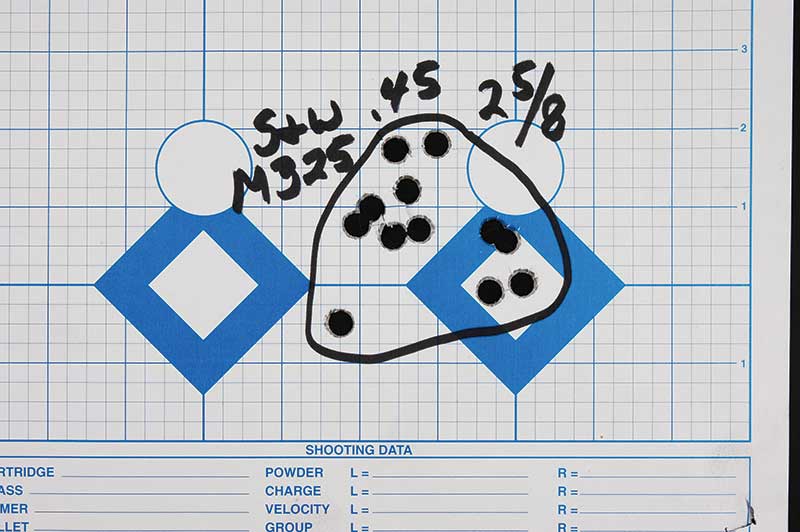
This 12-shot group (above) was fired with the S&W Model 325PD .45 ACP AirLite at 25 yards with
the revolver mounted in a Ransom Machine Rest. Practical accuracy is very good, if you can stand
behind it. This 12-shot group (below) was fired with the S&W Model 325PD .41 Magnum AirLite at
25 yards with it also mounted in a Ransom Machine Rest.
Number Soup
As I said before, these three handguns were just samples of Smith & Wesson’s line of AirLite handguns. Also available are a Model 329 .44 Magnum, Model 327 and 386 .357 Magnums, 351 .22 Magnums, 340s .357 Magnums, etc. The big .44 is a sixgun, the Model 327 is an 8-shooter on an N-frame while the Model 386 is a seven shooter on the mid-size frame (see John Taffin’s article in April’s issue). The .22 Mag is a seven shooter, and the Model 340 is another J-frame so it’s back to a five shooter. By the way, its one of their hammerless models, and I’m eyeing one of them to be “my” new gun, and passing the ham-mered Model 360 on to Yvonne.
These new Smith & Wesson AirLite revolvers are not cheap. The old natural law “you have to give something to get something” comes into play here. Mainly you have to give a little extra money in order to gain not having all the extra weight steel brings in a handgun.
Nobody will ever read where I’ve recommended taking these AirLite revolvers out for lots of practice and fun shooting. Use steel-frame guns to build your competency with and for fun shooting. But, personally I think Smith & Wesson’s AirLite revolvers fill a needed niche.

Get More Revolver Content Every Week!
Sign up for the Wheelgun Wednesday newsletter here:

